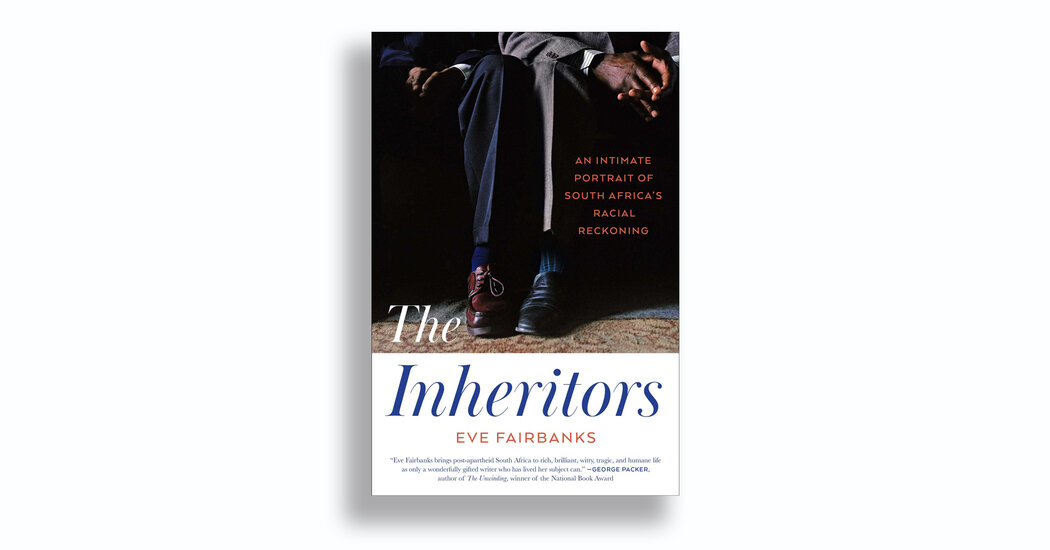
THE INHERITORS
An Intimate Portrait of South Africa’s Racial Reckoning
By Eve Fairbanks
399 pages. Simon & Schuster. $27.99.
It was nothing short of a miracle — that was what South African schoolchildren were taught when Nelson Mandela was elected president in 1994, in the country’s first fully democratic elections. Apartheid, the brutal system of white minority rule that made South Africa a global pariah, was over. As Eve Fairbanks writes in “The Inheritors,” her new book about the decades before and after that transition, its miraculousness “was like mathematics, amazing but incontrovertible.”
But Malaika, one of the central figures in this account, remembers that her teachers’ soaring language seemed completely out of step with what she endured in her daily life. Born a few years before the end of apartheid, she continued to live in a shack in Soweto, a Black township on the outskirts of Johannesburg. She and her mother, Dipuo, were still poor. They still had days when they were hungry. When Malaika was 11, her mother sent her to a school in a formerly white neighborhood; Malaika had only old shoes to wear, with holes on the bottoms. “Shine the top,” her grandmother would tell her. “People can’t see underneath your shoe.”
Others may not have seen it, but Malaika could certainly feel it. And how people feel turns out to be an essential part of Fairbanks’s book, one that took her a dozen years to report and write. “The Inheritors” tells South Africa’s story mainly through the experiences of Malaika and Dipuo, along with Christo, a white lawyer who as a young recruit worked as a soldier for the apartheid regime before it collapsed.
Fairbanks is too good a writer to resort to crude psychologizing, but she repeatedly suggests that there is a terrible price to pay for trying to ignore how people see their own situations; the undeniable material facts of everything that happens to them are often inseparable from an emotional reality.
Fairbanks grew up in Virginia and moved to South Africa as an adult in 2009. She writes as both an insider and an outsider, having spent years listening to the people she meets, taking in not only what they choose to tell her but also what they let slip because of any prejudices they take for granted.
The word “them,” for instance: When she first arrived, Fairbanks was startled to hear how many white South Africans used the word as a catch-all for Black people. She recalls how one of her friends, “a left-wing political activist,” called her in a fury when his car was stolen by persons unknown, nevertheless insisting “they” did it. He seemed confused when Fairbanks pushed him on his presumption: “It had never occurred to him it was a strange thing to say.”
What she saw was a country so deformed by apartheid that after it ended, some white people found it unbearable when Black people treated them with forbearance instead of the vengeful reprisals they had been conditioned to expect. “Things went better than almost any white person might have imagined,” Fairbanks writes. Even Christo, who initially faced charges of terrorism for having accidentally killed a homeless Black man when he was on a mission, saw that his past “could be washed clean.” You might think he would be grateful for such mercy, but he insisted it was a “subtle degradation.” Fairbanks describes how Christo wanted to believe that he was hated: “How dare you hold up a mirror of graciousness that shows me the reflection of a worse man than you?”
This “mirror of graciousness” wasn’t something that Malaika, for one, was especially interested in providing. In college, she started writing scathing essays on Facebook that were rapturously received by the white elites she most witheringly criticized. She felt baffled, and then resentful. She bristled at how ostentatiously some white people liked to flaunt their generosity — “celebrating their own willingness to take a punch.”
Fairbanks tells these stories against the larger backdrop of a changing country — land reform, the AIDS crisis, brazen corruption and economic troubles. Malaika and Dipuo felt let down by Mandela and the African National Congress, whose post-apartheid economic policies were skewed toward placating skittish international markets instead of enacting the redistribution that Dipuo, formerly an activist, had hoped for. She remembers being struck by Mandela’s “hectoring, patronizing turn” toward a kind of respectability politics. He would repeatedly lecture Black South Africans on how it was their responsibility to make white people feel reassured.
What Fairbanks notices toward the end of the book is a collective hardening, as a younger generation of white supremacists have shamelessly donned the mantle of victimhood, presenting Afrikaners as an “endangered ethnic minority.” Fairbanks says that this kind of provocation is a concerted attempt to goad Black South Africans, “inflaming” their anger. The Afrikaners’ trolling may have already had an effect; Malaika tells Fairbanks of a friend who has been radicalized to the point where “she doesn’t believe white people have the capacity for humanity.” Malaika, still sharply critical of white South Africans, admits that her friend’s fury “scared even me.”
In addition to being an elegant writer, Fairbanks is unfailingly empathetic; she draws out tangled emotions with such skill and sensitivity that I was mystified by a few awkward analogies — like when she recalls arguments with ex-boyfriends because they reminded her of the psychodynamics she was observing in post-apartheid South Africa. More resonant are the echoes she finds in the current American situation, where multiple reckonings are happening at once, but in comparative slow-motion. “South Africans never had the luxury of dawdling at the psychological precipice of great change,” she writes. “In the blink of an eye, in the tallying of a vote, they were in it.”




